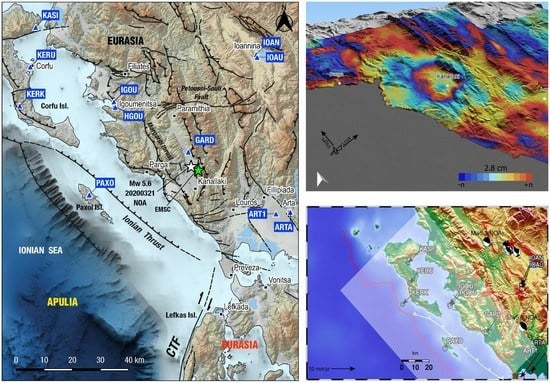The Mw = 5.6 Kanallaki Earthquake of 21 March 2020 in West Epirus, Greece: Reverse Fault Model from InSAR Data and Seismotectonic Implications for Apulia-Eurasia Collision
Abstract
:1. Introduction
2. Seismicity
2.1. The 21 March 2020 Earthquake—Relocation of Seismicity
2.2. Historical Seismicity and the 1895 Event
3. Geodesy
3.1. Interferograms
3.2. Geodetic Data Inversion: Picking Quarter of Fringes
| Pixel Value | Number of Available Pixels | Number of Selected Pixels | Displacement in the Line of Sight (mm) |
|---|---|---|---|
| 32 | 161 | 18 | 31.5 |
| 96 | 25 | 19 | 24.4 |
| 160 | 24 | 21 | 17.5 |
| 224 | 37 | 28 | 10.5 |
| Total | 247 | 86 |
3.3. Results of Inversion Modelling
4. Discussion
4.1. Characteristics of the Kanallaki Seismic Fault
4.2. Revision of the Magnitude and Location of the 1895 Earthquake in West Epirus
4.3. Tectonic Strain and the Determination of the Deformation Zone across the Apulia—Eurasia Plate Boundary
4.4. On the Regional Extent of On-Going Compression in Epirus and the Significance of the Ioannina 2016 Compressional Event
5. Conclusions
- The main source of the Mw = 5.6 earthquake that hit western-central Epirus on 21 March 2020 was identified to be located on the Margariti thrust fault, within the frontal area of the Ionian fold and thrust belt of the Hellenic orogen;
- The seismic fault was modelled by combining the ascending and descending Sentinel-1 observations. It was found that we could model the overall fringe pattern by reverse slip on an east-dipping fault. The fault plane is a low-angle thrust fault (~5 by 5 km) that dips 39° towards east;
- The inversion of geodetic data suggests that the upper edge of the fault is at a depth of 7 km, well constrained by the modelling of the interferograms;
- The geodetic centroid of the slip plane is located at 8.5 km depth which is in agreement with our revised moment tensor solution that provided a centroid depth of 8 km;
- InSAR showed ground motion towards the southwest and surface uplift in agreement with moment tensor solutions from seismology;
- The damage distribution of the 14 May, 1895 M5.8 ± 0.3 damaging earthquake was found to be compatible with a reverse-slip rupture along the Margariti thrust;
- Deep crustal seismicity near Ioannina is of a compressional type and is due to ongoing crustal shortening between Apulia and Eurasia;
- GNSS data indicate that the extent of the deforming crustal area between Apulia–Epirus (from offshore Paxoi until Kanallaki), accommodating 80% of the total convergence, is 60 km, with a best fitting locking depth of 11 km;
- The shortening rate of the crust between the Epirus coastal GNSS stations and station PAXO in the Ionian Sea (i.e., across the Ionian Thrust) is equivalent to 4.6 mm yr−1 or ~50% of the overall convergence;
- The island of Paxoi appeared to already be on the Apulian side of the deforming zone, while it is exactly the opposite for the GNSS stations onshore Corfu (KASI, KERK, and KERU, Figure 13), with the axis of the plate boundary zone between Africa passing close to both islands and continuing along the coast of Albania.
Supplementary Materials
Author Contributions
Funding
Acknowledgments
Conflicts of Interest
References
- Underhill, J.R. Late Cenozoic deformation of the Hellenide foreland, western Greece. Geol. Soc. Am. Bull. 1989, 101, 613–634. [Google Scholar] [CrossRef]
- King, G.; Sturdy, D.; Whitney, J. The landscape geometry and active tectonics of northwest Greece. Geol. Soc. Am. Bull. 1993, 105, 137–161. [Google Scholar] [CrossRef]
- Karakitsios, V. Western Greece and Ionian Sea petroleum systems. AAPG Bull. 2013, 97, 1567–1595. [Google Scholar] [CrossRef] [Green Version]
- Handy, M.R.; Giese, J.; Schmid, S.M.; Pleuger, J.; Spakman, W.; Onuzi, K.; Ustaszewski, K. Coupled crust-mantle response to slab tearing, bending, and rollback along the Dinaride-Hellenide orogen. Tectonics 2019, 38, 2803–2828. [Google Scholar] [CrossRef]
- Olive, J.-A.; Pearce, F.; Rondenay, S.; Behn, M.D. Pronounced zonation of seismic anisotropy in the Western Hellenic subduction zone and its geodynamic significance. Earth Planet. Sci. Lett. 2014, 391, 100–109. [Google Scholar] [CrossRef]
- Hatzfeld, D.; Kassaras, I.; Panagiotopoulos, D.; Amorese, D.; Makropoulos, K.; Karakaisis, G.; Coutant, O. Microseimicity and strain pattern in northwestern Greece. Tectonics 1995, 14, 773–785. [Google Scholar] [CrossRef]
- Baker, C.; Hatzfeld, D.; Lyon-Caen, H.; Papadirnitriou, E.; Rigo, A. Earthquake mechanisms of the Adriatic Sea and Western Greece: Implications for the oceanic subduction-continental collision transition. Geophys. J. Int. 1997, 131, 559–594. [Google Scholar] [CrossRef] [Green Version]
- Louvari, E.; Kiratzi, A.; Papazachos, B.; Hatzidimitriou, P. Fault-plane solutions determined by waveform modeling confirm tectonic collision in the eastern Adriatic. Pure Appl. Geophys. 2001, 158, 1613–1637. [Google Scholar] [CrossRef]
- Tselentis, G.A.; Sokos, E.; Martakis, N.; Serpetsidaki, A. Seismicity and seismotectonics in Epirus, western Greece: Results from a microearthquake survey. Bull. Seismol. Soc. Am. 2006, 96, 1706–1717. [Google Scholar] [CrossRef] [Green Version]
- Pérouse, E.; Chamot-Rooke, N.; Rabaute, A.; Briole, P.; Jouanne, F.; Georgiev, I.; Dimitrov, D. Bridging onshore and offshore present-day kinematics of central and eastern Mediterranean: Implications for crustal dynamics and mantle flow. Geochem. Geophys. Geosyst. 2012, 13. [Google Scholar] [CrossRef] [Green Version]
- D’Agostino, N.; Métois, M.; Koci, R.; Duni, L.; Kuka, N.; Ganas, A.; Georgiev, I.; Jouanne, F.; Kaludjerovic, N.; Kandić, R. Active crustal deformation and rotations in the southwestern Balkans from continuous GPS measurements. Earth Planet. Sci. Lett. 2020, 539, 116246. [Google Scholar] [CrossRef]
- Van Hinsbergen, D.J.J.; van der Meer, D.G.; Zachariasse, W.J.; Meulenkap, J.E. Deformation of western Greece during Neogene clockwise rotation and collision with Apulia. Int. J. Earth Sci. 2005, 95, 463. [Google Scholar] [CrossRef]
- Zelilidis, A.; Piper, D.J.W.; Vakalas, I.; Avramidis, P.; Getsos, K. Oil and gas plays in Albania: Do equivalent plays exist in Greece? J. Pet. Geol. 2006, 26, 29–48. [Google Scholar] [CrossRef]
- IGRS-IFP. Etude Géologique de l’Εpire (Grèce Nord-occidentale); Editions Technip: Paris, France, 1966; p. 306. [Google Scholar]
- Monopolis, D.; Bruneton, A. Ionian Sea (western Greece): Its structural outline deduced from drilling and geophysical data. Tectonophysics 1982, 83, 227–242. [Google Scholar] [CrossRef]
- Paschos, P.; Rondoyianni, T.; Mettos, A. Neotectonic Map of Greece in Scale 1:100000, Map Sheet Arta; Institute of Geology and Mineral Exploration: Athens, Greece, 2011. [Google Scholar]
- Ntokos, D. Neotectonic study of Northwestern Greece. J. Maps 2018, 14, 178–188. [Google Scholar] [CrossRef] [Green Version]
- Lekkas, E.; Mavroulis, S.; Carydis, P.; Skourtsos, E.; Kaviris, G.; Paschos, P.; Ganas, A.; Kazantzidou-Firtinidou, D.; Parcharidis, I.; Gatsios, T.; et al. The March 21, 2020, Mw 5.7 Epirus (Greece) Earthquake; Newsletter of Environmental, Disaster and Crises Management Strategies; Department of Geology and Geoenvironment, National and Kapodistrian University of Athens: Athens, Greece, 2020; ISSN 2653-9454. [Google Scholar]
- Sokos, E.N.; Zahradnik, J. ISOLA a Fortran code and a Matlab GUI to perform multiple-point source inversion of seismic data. Comput. Geosci. 2008, 34, 967–977. [Google Scholar] [CrossRef]
- Haslinger, F.; Kissling, E.; Ansorge, J.; Hatzfeld, D.; Papadimitriou, E.; Karakostas, V.; Makropoulos, K.; Kahle, H.-G.; Peter, Y. 3D crustal structure from local earthquake tomography around the Gulf of Arta (Ionian region, NW Greece). Tectonophysics 1999, 304, 201–218. [Google Scholar] [CrossRef]
- Karakonstantis, A. 3-D Simulation of Crust and Upper Mantle Structure in the Broader Hellenic Area Through Seismic Tomography. Ph.D. Thesis, Department of Geophysics-Geothermics, Faculty of Geology, University of Athens, Athens, Greece, March 2017. [Google Scholar]
- Wadati, K. On the travel time of earthquake waves. Part. II. Geophys. Mag. 1933, 7, 101–111. [Google Scholar]
- Waldhauser, F. hypoDD-A Program to Compute Double-Difference Hypocenter Locations. US Geol. Surv. Open File Rep. 2001, 1, 113. [Google Scholar]
- Papazachos, B.; Papazachou, C. The Earthquakes of Greece; Editions Ziti: Thessaloniki, Greece, 1997. [Google Scholar]
- Ambraseys, N. Earthquakes in the Mediterranean and Middle East: A Multidisciplinary Study of Seismicity up to 1900; Cambridge University Press: Cambridge, UK, 2009; p. 970. [Google Scholar]
- Makropoulos, K.; Kaviris, G.; Kouskouna, V. An updated and extended earthquake catalogue for Greece and adjacent areas since 1900. Nat. Hazards Earth Syst. Sci. 2012, 12, 1425–1430. [Google Scholar] [CrossRef] [Green Version]
- Kontoes, C.; Elias, P.; Sykioti, O.; Briole, P.; Remy, D.; Sachpazi, M.; Veis, G.; Kotsis, I. Displacement field and fault model for the September 7, 1999 Athens Earthquake inferred from ERS2 Satellite radar interferometry. Geophys. Res. Lett. 2000, 27, 3989–3992. [Google Scholar] [CrossRef] [Green Version]
- Atzori, S.; Manunta, M.; Fornaro, G.; Ganas, A.; Salvi, S. Postseismic displacement of the 1999 Athens earthquake retrieved by the Differential Interferometry by Synthetic Aperture Radar time series. J. Geophys. Res. 2008, 113. [Google Scholar] [CrossRef]
- Briole, P.; Elias, P.; Parcharidis, O.; Bignami, C.; Benekos, G.; Samsonov, S.; Kyriakopoulos, C.; Stramondo, S.; Chamot-Rooke, N.; Drakatou, M.L.; et al. The seismic sequence of January–February 2014 at Cephalonia Island (Greece): Constraints from SAR interferometry and GPS. Geophys. J. Int. 2015, 203, 1528–1540. [Google Scholar] [CrossRef] [Green Version]
- Ilieva, M.; Briole, P.; Ganas, A.; Dimitrov, D.; Elias, P.; Mouratidis, A.; Charara, R. Fault plane modelling of the 2003 August 14 Lefkada Island (Greece) earthquake based on the analysis of ENVISAT SAR interferograms. Tectonophysics 2016, 693, 47–65. [Google Scholar] [CrossRef]
- Ganas, A.; Elias, P.; Bozionelos, G.; Papathanassiou, G.; Avallone, A.; Papastergios, A.; Valkaniotis, S.; Parcharidis, I.; Briole, P. Coseismic deformation, field observations and seismic fault of the 17 November 2015 M = 6.5, Lefkada Island, Greece earthquake. Tectonophysics 2016, 687, 210–222. [Google Scholar] [CrossRef]
- Ganas, A.; Elias, P.; Kapetanidis, V.; Valkaniotis, S.; Briole, P.; Kassaras, I.; Argyrakis, P.; Barberopoulou, A.; Moshou, A. The July 20, 2017 M6.6 Kos Earthquake: Seismic and Geodetic Evidence for an Active North-Dipping Normal Fault at the Western End of the Gulf of Gökova (SE Aegean Sea). Pure Appl. Geophys. 2019, 176, 4177–4211. [Google Scholar] [CrossRef]
- Ganas, A.; Elias, P.; Briole, P.; Cannavo, F.; Valkaniotis, S.; Tsironi, V.; Partheniou, E.I. Ground Deformation and Seismic Fault Model of the M6.4 Durres (Albania) Nov. 26, 2019 Earthquake, Based on GNSS/INSAR Observations. Geosciences 2020, 10, 210. [Google Scholar] [CrossRef]
- Goldstein, R.M.; Werner, C.L. Radar interferogram filtering for geophysical applications. Geophys. Res. Lett. 1998, 25, 4035–4038. [Google Scholar] [CrossRef] [Green Version]
- Briole, P. Modelling of earthquake slip by inversion of GNSS and InSAR data assuming homogenous elastic medium. Zenodo 2017, 1. [Google Scholar] [CrossRef]
- Wells, D.L.; Coppersmith, K.L. New Empirical Relationships among Magnitude, Rupture Length, Rupture Width, Rupture Area and Surface Displacement. Bull. Seismol. Soc. Am. 1994, 84, 974–1002. [Google Scholar]
- Thingbaijam, K.K.S.; Martin Mai, P.; Goda, K. New empirical earthquake source-scaling laws. Bull. Seismol. Soc. Am. 2017, 107, 2225–2246. [Google Scholar] [CrossRef] [Green Version]
- Ganas, A. NOAFAULTS KMZ layer. Zenodo 2019, 2. [Google Scholar] [CrossRef]
- Bacopoulos, I. Lithostratigraphy of the Ionian Basin in the Southern Part of Epirus Related to the Migration and Entrapment of its Hydrocarbons. Ph.D. Thesis, University of Athens, Athens, Greece, 2006. [Google Scholar]
- Perrier, R.; Koukouzas, C. Geological Map of Greece in Scale 1:50000, Map Sheet Parga; Institute of Geology and Mineral Exploration: Athens, Greece, 1969. [Google Scholar]
- Provost, L.; Scotti, O. QUake-MD: Open-Source Code to Quantify Uncertainties in Magnitude–Depth Estimates of Earthquakes from Macroseismic Intensities. Seismol. Res. Lett. 2020, 91, 2520–2530. [Google Scholar] [CrossRef]
- Locati, M.; Rovida, A.; Albini, P.; Stucchi, M. The AHEAD Portal: A Gateway to European Historical Earthquake Data. Seismol. Res. Lett. 2014, 85, 727–734. [Google Scholar] [CrossRef] [Green Version]
- Stucchi, M.; Rovida, A.; Gomez Capera, A.A.; Alexandre, P.; Camelbeeck, T.; Demircioglu, M.B.; Gasperini, P.; Kouskouna, V.; Musson, R.M.W.; Radulian, M.; et al. The SHARE European Earthquake Catalogue (SHEEC) 1000–1899. J. Seismol. 2013, 17, 523–544. [Google Scholar] [CrossRef] [Green Version]
- Bakun, W.H.; Scotti, O. Regional intensity attenuation models for France and the estimation of magnitude and location of historical earthquakes. Geophys. J. Int. 2006, 164, 596–610. [Google Scholar] [CrossRef] [Green Version]
- Baumont, D.; Manchuel, K.; Traversa, P.; Durouchoux, C.; Nayman, E.; Ameri, G. Intensity predictive attenuation models calibrated in Mw for metropolitan France. Bull. Earthq. Eng. 2018, 16, 2285–2310. [Google Scholar] [CrossRef]
- Ganas, A.; Drakatos, G.; Rontogianni, S.; Tsimi, C.; Petrou, P.; Papanikolaou, M.; Argyrakis, P.; Boukouras, K.; Melis, N.; Stavrakakis, G. NOANET: The new permanent GPS network for Geodynamics in Greece. Eur. Geophys. Union Geophys. Res. Abstr. 2008, 10, 43–80. [Google Scholar]
- Ganas, A.; Marinou, A.; Anastasiou, D.; Paradissis, D.; Papazissi, K.; Tzavaras, P.; Drakatos, G. GPS-derived estimates of crustal deformation in the central and north Ionian Sea, Greece: 3-yr results from NOANET continuous network data. J. Geodyn. 2013, 67, 62–71. [Google Scholar] [CrossRef]
- Zumberge, J.F.; Heflin, M.B.; Jefferson, D.C.; Watkins, M.M.; Webb, F.H. Precise point positioning for the efficient and robust analysis of GPS data from large networks. J. Geophys. Res. Space Phys. 1997, 102, 5005–5017. [Google Scholar] [CrossRef] [Green Version]
- Bertiger, W.; Desai, S.D.; Haines, B.; Harvey, N.; Moore, A.W.; Owen, S.; Weiss, J.P. Single receiver phase ambiguity resolution with GPS data. J. Geod. 2010, 84, 327–337. [Google Scholar] [CrossRef]
- Métois, M.; D’Agostino, N.; Avallone, A.; Chamot-Rooke, N.; Rabaute, A.; Duni, L.; Kuka, K.; Koci, R.; Georgiev, I. Insights on continental collisional processes from GPS data: Dynamics of the peri-Adriatic belts. J. Geophys. Res. Solid Earth 2015, 120, 8701–8719. [Google Scholar] [CrossRef] [Green Version]
- Ntokos, D.; Lykoudi, E.; Rondoyanni, T. Geomorphic analysis in areas of low-rate neotectonic deformation: South Epirus (Greece) as a case study. Geomorphology 2016, 263, 156–169. [Google Scholar] [CrossRef]
- Van Hinsbergen, D.J.J.; Langereis, C.G.; Meulenkamp, J.E. Revision of the timing, magnitude and distribution of Neogene rotations in the western Aegean region. Tectonophysics 2005, 396, 1–34. [Google Scholar] [CrossRef]
- The Institute of Engineering Seismology and Earthquake Engineering. Preliminary Report on the 15/10/2016 Ioannina M5.5 Earthquake; Institute of Engineering Seismology and Earthquake Engineering: Thessaloniki, Greece, 2016; p. 13. (In Greek) [Google Scholar]
- Pavlides, S.; Ganas, A.; Papathanasiou, G.; Valkaniotis, S.; Thomaidou, E.; Georgiadis, G.; Sboras, S.; Chatzipetros, A. Geological-seismotectonic study of the wider area of Ioannina. In Proceedings of the Tectonics & Structural Geology Committee of the G.S.G. 1st TSG Meeting, Athens, Greece, 6 December 2016. [Google Scholar]
- Pavlides, S.; Ganas, A.; Chatzipetros, A.; Sboras, S.; Valkaniotis, S.; Papathanassiou, G.; Thomaidou, E.; Georgiadis, G. Geological and seismotectonic characteristics of the broader area of the 15 October 2016, earthquake (Ioannina, Greece). Eur. Geophys. Union Geophys. Res. Abstracts 2017, 19, 18135. [Google Scholar]

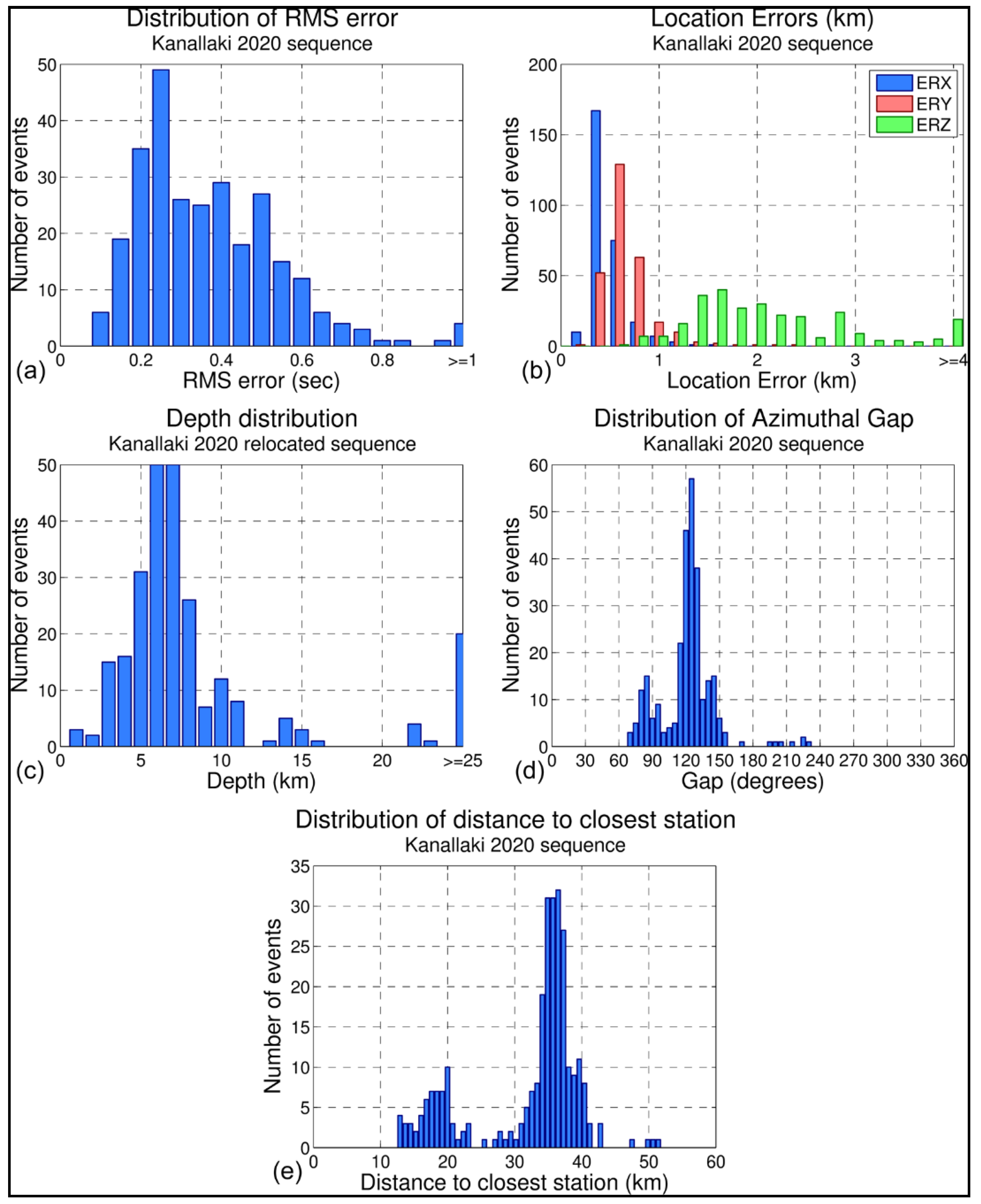

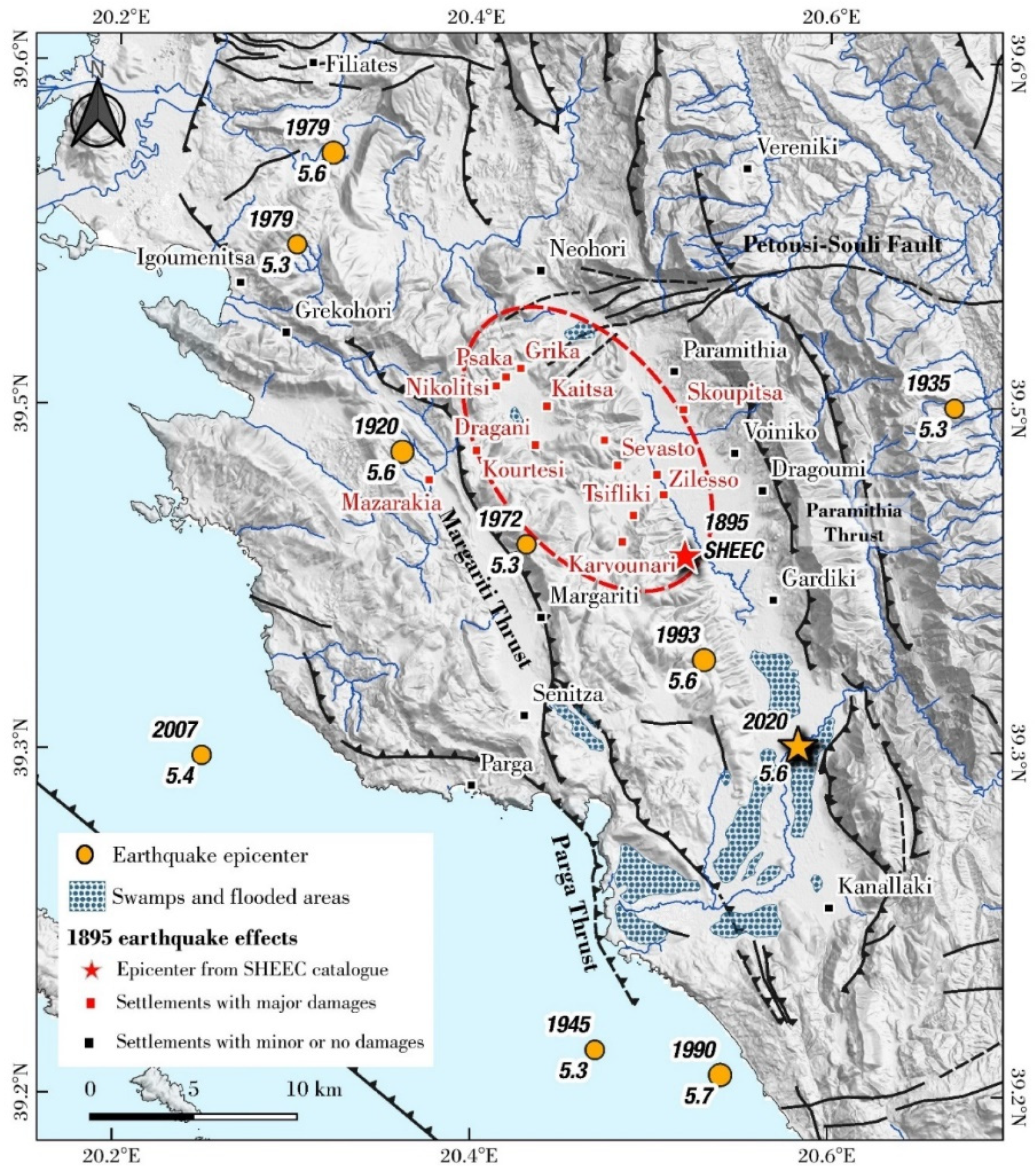


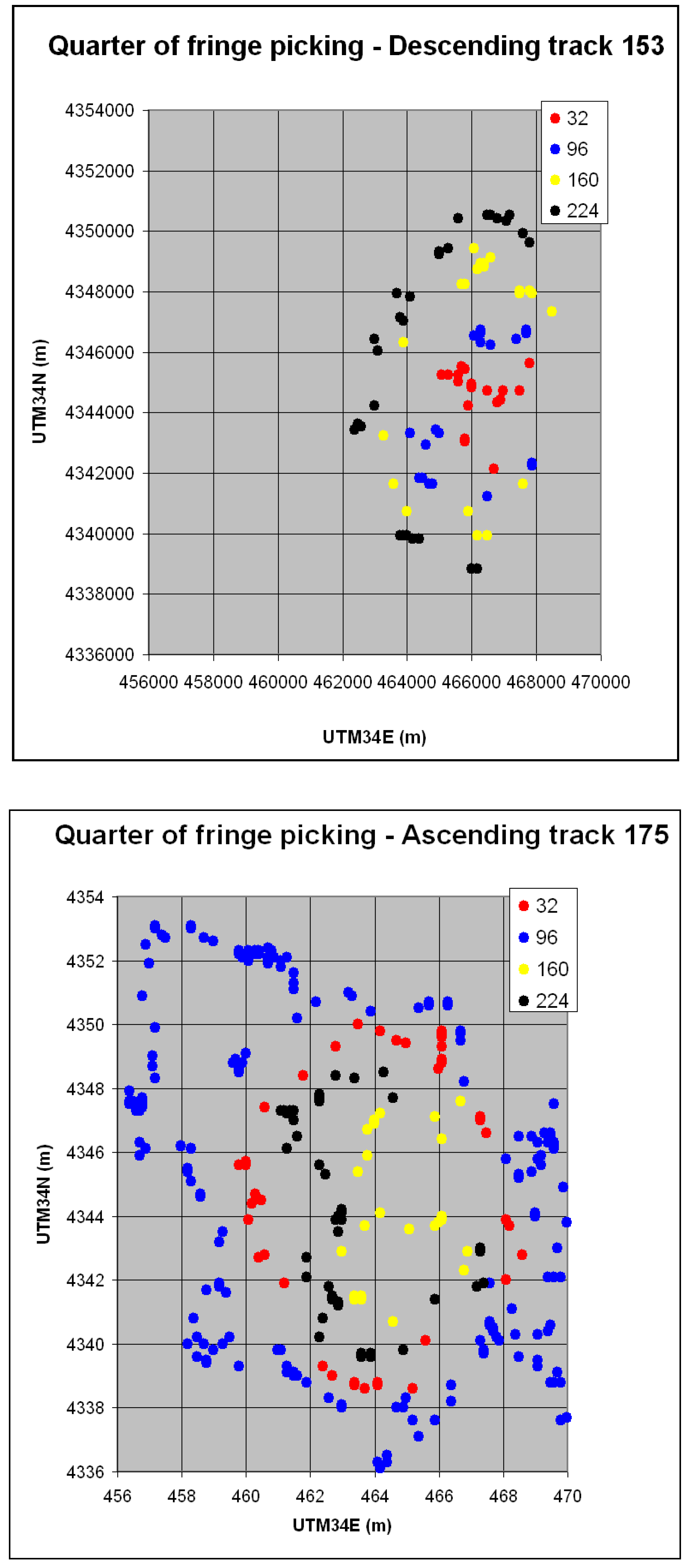
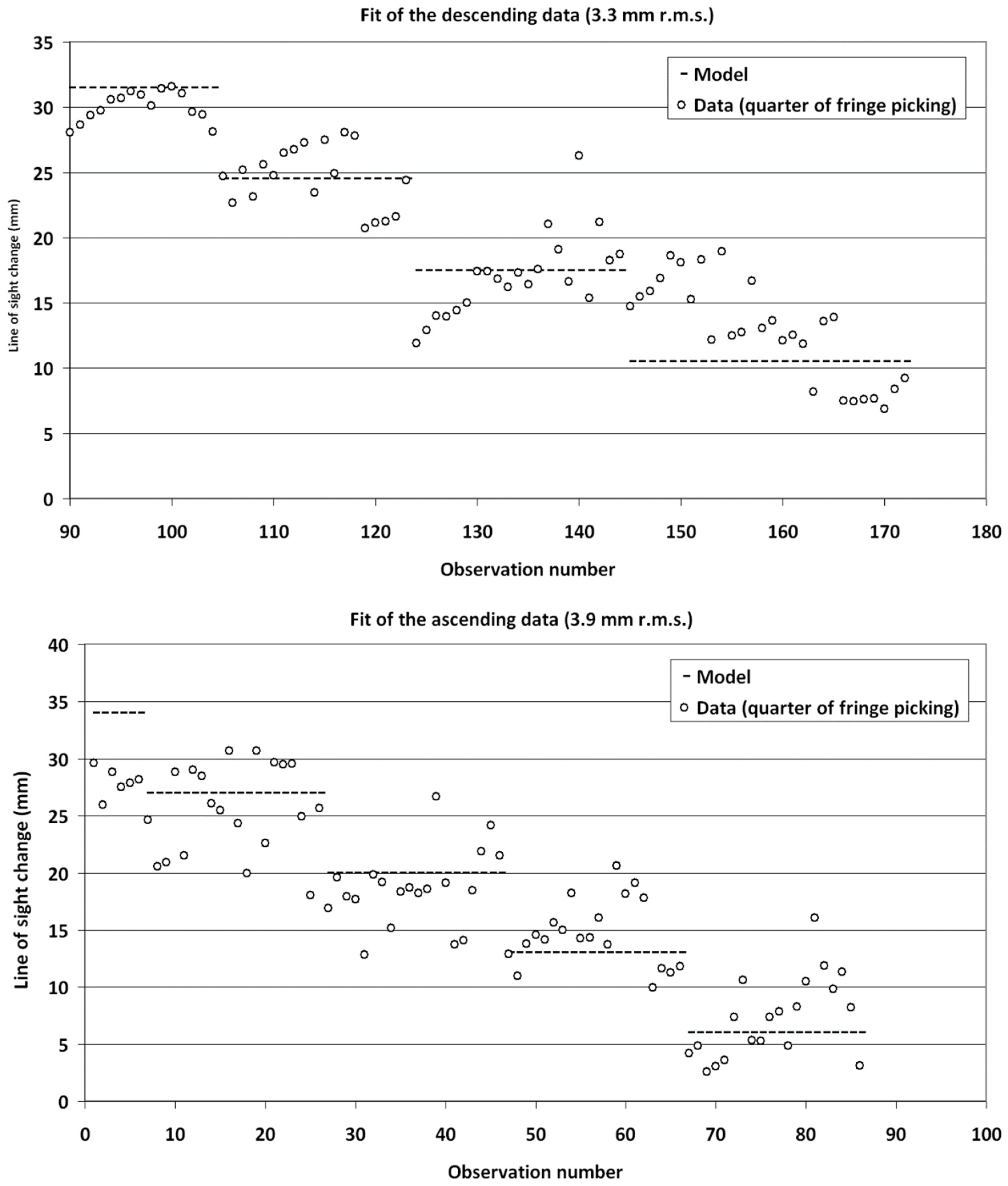


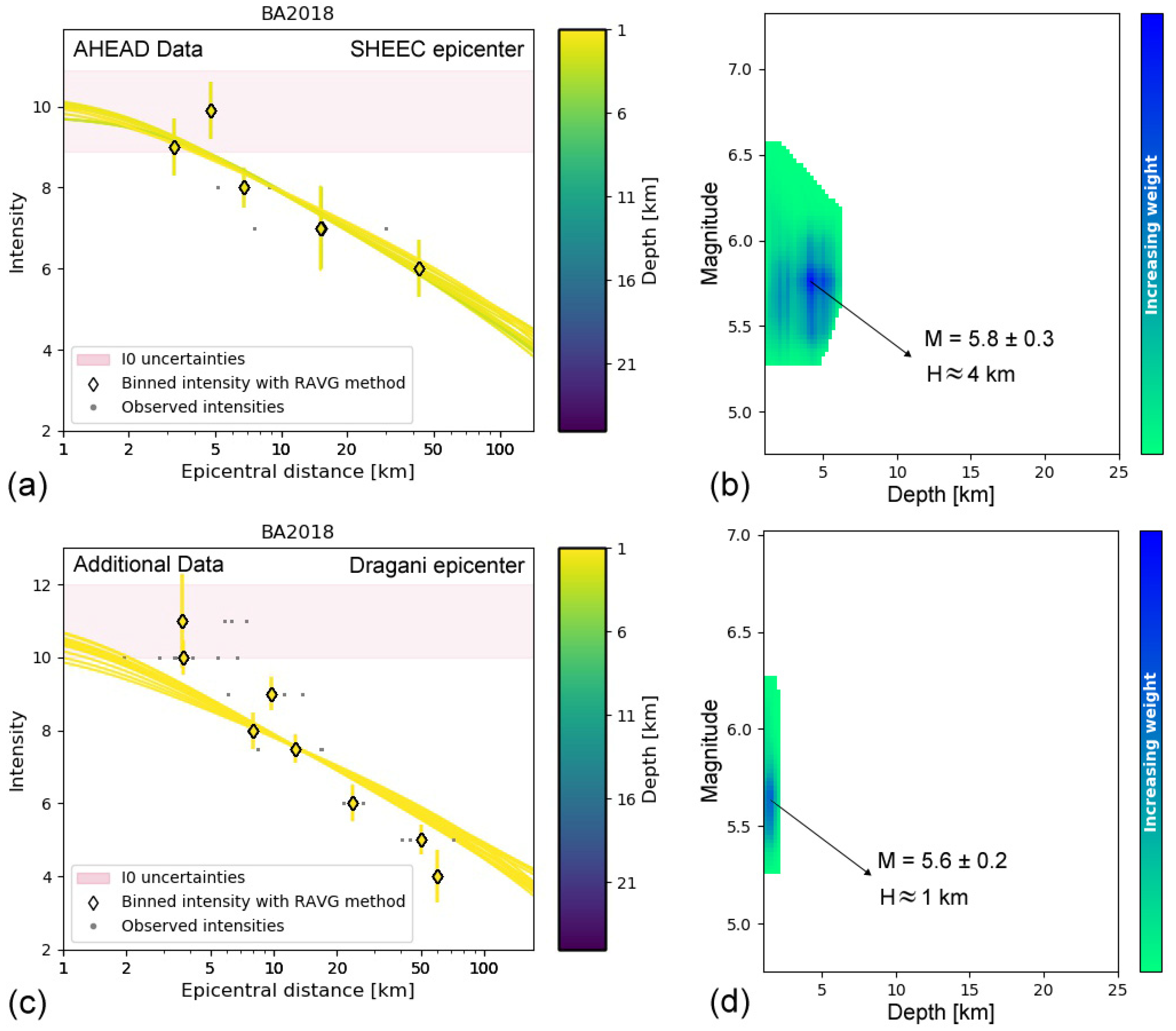

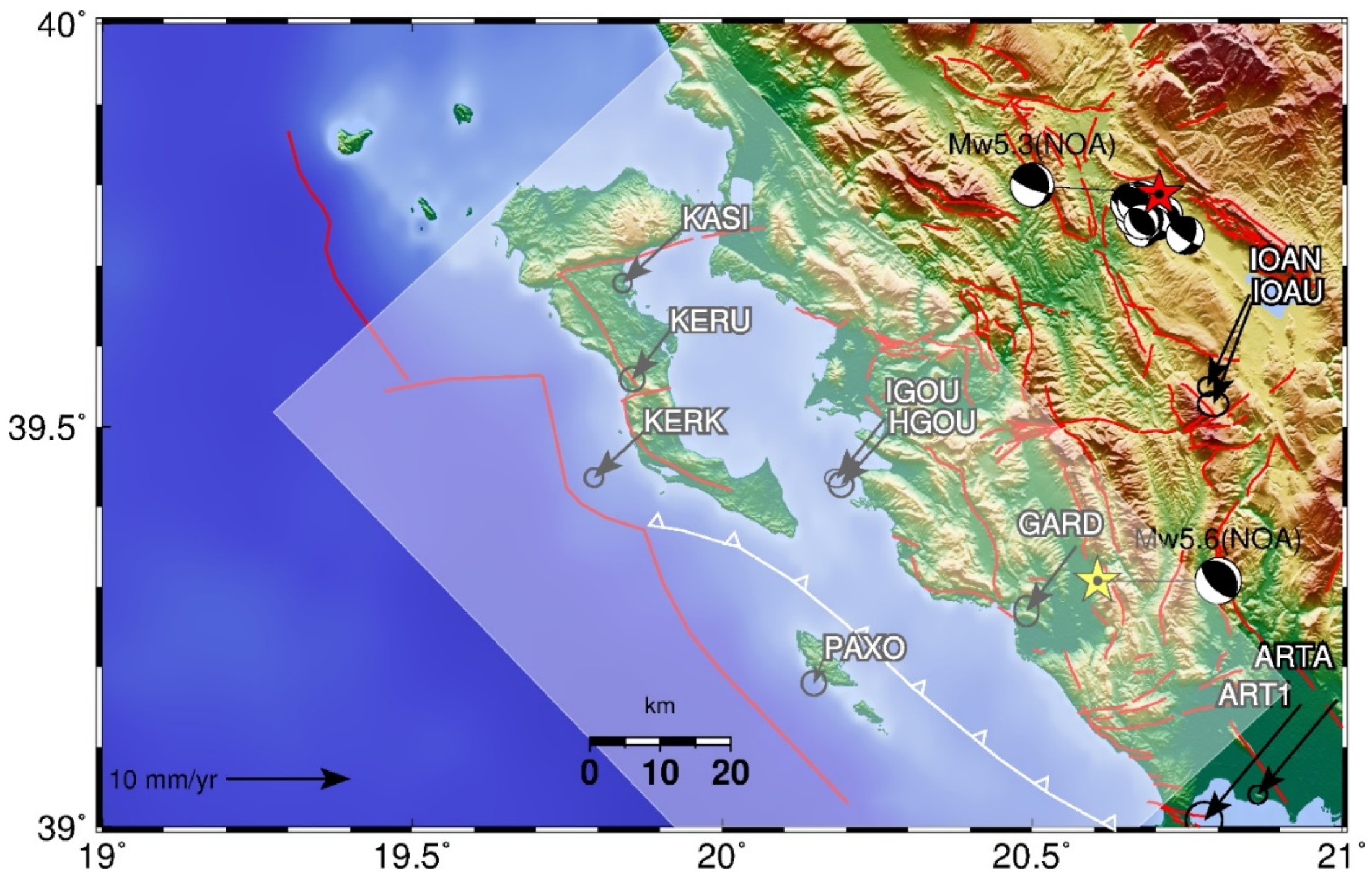
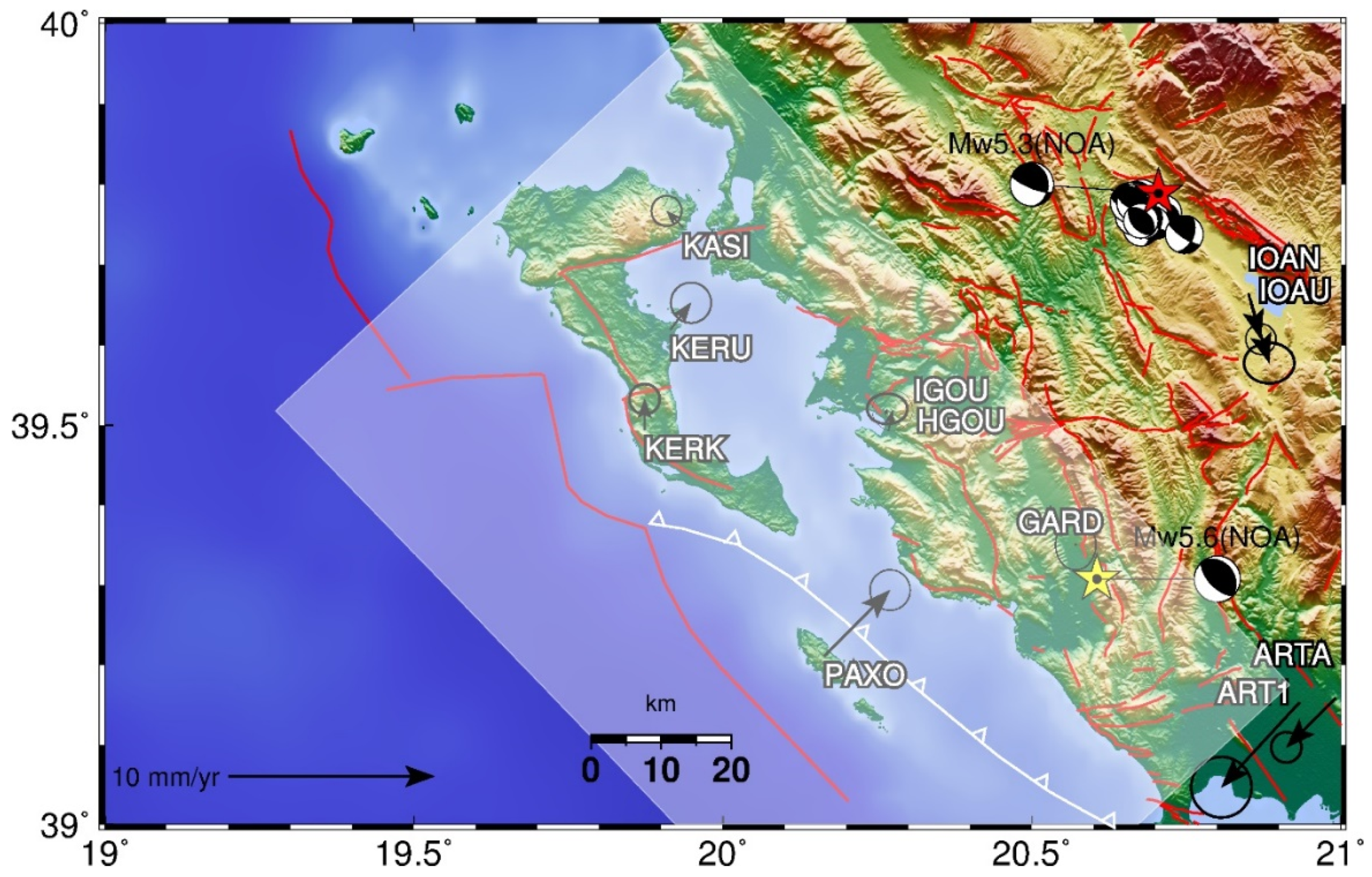
| dd/mm/yyyy HH:MM | Epicentre | Hypocentral Depth (km) | Mw | Strike/Dip/Rake 1 | Strike/Dip/Rake 2 | P-axis Azimuth/Plunge | T-axis Azimuth/Plunge |
|---|---|---|---|---|---|---|---|
| 20 March 2020 21:38 | 39.3123N 20.5650E | 14.7 | 4.2 | 133/56/82 | 328/35/102 | 229/10 | 14/77 |
| 21 March 2020 00:49 | 39.3265N 20.5215E | 7.9 | 5.5 | 315/33/92 | 132/57/89 | 223/12 | 38/78 |
| 21 March 2020 00:49 | 39.3025N 20.5829E (re-located) | 6.4 | 5.6 | 129/59/72 | 341/36/117 | 232/12 | 358/71 |
| 23 March 2020 04:41 | 39.3027N 20.5966E | 14.1 | 3.8 | 293/60/9 | 199/82/149 | 250/15 | 152/27 |
| 25 March 2020 09:49 | 39.2757N 20.6218E | 13.4 | 3.9 | 141/63/74 | 353/31/118 | 242/17 | 21/68 |
| Layer | VP (km/s) | Ceiling Depth (km) |
|---|---|---|
| 1 | 4.6 | 0.0 |
| 2 | 5.7 | 7.0 |
| 3 | 6.1 | 11.0 |
| 4 | 6.3 | 11.5 |
| 5 | 6.5 | 16.5 |
| 6 | 7.3 | 35.0 |
| 7 | 8.0 | 80.0 |
| Agency | Strike NP1 | Dip NP1 | Rake NP1 | Strike NP2 | Dip NP2 | Rake NP2 | Centroid Depth | Moment |
|---|---|---|---|---|---|---|---|---|
| ° | ° | ° | ° | ° | ° | km | × 1017 N m | |
| GCMT | 338 | 38 | 122 | 120 | 59 | 68 | 13.6 | 4.93 |
| GFZ | 318 | 37 | 90 | 137 | 52 | 89 | 20 | 4.10 |
| IPGP | 331 | 35 | 100 | 139 | 56 | 83 | 10 | 6.61 |
| USGS | 317 | 52 | 87 | 142 | 39 | 93 | 13.5 | 4.04 |
| NOA | 315 | 33 | 92 | 132 | 57 | 89 | 8 | 2.38 |
| NOA revised (this study) | 341 | 36 | 117 | 129 | 59 | 72 | 8 | 2.86 |
| AUTH | 336 | 38 | 105 | 137 | 53 | 78 | 7 | 3.82 |
| INGV | 333 | 42 | 107 | 131 | 50 | 75 | 14.2 | 4.80 |
| average | 329 | 39 | 103 | 133 | 53 | 81 | 12 | |
| standard deviation | 10 | 6 | 12 | 6 | 6 | 8 | 4 |
| Pixel Value | Number of Available Pixels | Number of Selected Pixels | Displacement in the Line of Sight (mm) |
|---|---|---|---|
| 96 | 6 | 6 | 34 |
| 160 | 24 | 20 | 27 |
| 224 | 42 | 20 | 20 |
| 32 | 40 | 20 | 13 |
| 96 | 177 | 20 | 6 |
| Total | 289 | 86 |
| Max. l.o.s. Change | Fault Length | Geodetic Moment Tensor | |||
|---|---|---|---|---|---|
| Easting | Northing | Depth | × 1017 N m | ||
| km | km | km | km | ||
| 28 mm | 465.45 | 4344.38 | 7.29 | 4.32 | 2.27 |
| 31.5 mm | 465.44 | 4344.41 | 7.99 | 5.7 | 2.99 |
| Centre of Upper Edge of the Fault | Fault Length | ||
|---|---|---|---|
| East | North | Vertical | |
| UTM34 (km) | UTM34 (km) | km | km |
| 464.76 | 4344.28 | 7.0 | 4.7 |
| Site | Network | Long | Lat | vE | vN | vE_Apulia | vN_Apulia |
|---|---|---|---|---|---|---|---|
| ° | ° | mm yr−1 | mm yr−1 | mm yr−1 | mm yr−1 | ||
| KERK | HxSmart | 19.8734 | 39.4937 | 21.1 ± 0.3 | 14.7 ± 0.3 | −4.0 | −3.7 |
| KERU | Tree | 19.9152 | 39.6191 | 22.1 ± 0.4 | 14.5 ± 0.4 | −3.0 | −3.9 |
| KASI | NOA | 19.9355 | 39.7464 | 20.3 ± 0.3 | 14.0 ± 0.3 | −4.8 | −4.4 |
| PAXO | HxSmart | 20.1639 | 39.2108 | 24.3 ± 0.4 | 16.4 ± 0.4 | −0.8 | −2.0 |
| IGOU | HxSmart | 20.2627 | 39.5100 | 21.2 ± 0.4 | 13.6 ± 0.3 | −3.9 | −4.8 |
| HGOU | Tree | 20.2679 | 39.4927 | 21.3 ± 0.4 | 14.2 ± 0.4 | −3.8 | −4.2 |
| GARD | Tree | 20.5710 | 39.3506 | 21.1 ± 0.4 | 13.2 ± 0.5 | −4.0 | −5.2 |
| IOAN | HxSmart | 20.8505 | 39.6641 | 21.7 ± 0.3 | 11.0 ± 0.3 | −3.4 | −7.4 |
| IOAU | Tree | 20.8541 | 39.6549 | 22.0 ± 0.5 | 10.2 ± 0.4 | −3.1 | −8.2 |
| ART1 | HxSmart | 20.9333 | 39.1529 | 17.3 ± 0.6 | 9.1 ± 0.6 | −7.8 | −9.3 |
| ARTA | HxSmart | 20.9917 | 39.1588 | 18.7 ± 0.3 | 10.8 ± 0.3 | −6.4 | −7.6 |
| Station | Convergence towards Apulia | Uncertainty |
|---|---|---|
| mm yr−1 | mm yr−1 | |
| KERK | 5.4 | 0.3 |
| KERU | 4.8 | 0.4 |
| KASI | 6.5 | 0.3 |
| PAXO | 1.9 | 0.4 |
| IGOU | 6.1 | 0.4 |
| HGOU | 5.6 | 0.4 |
| GARD | 6.5 | 0.5 |
| IOAN | 7.5 | 0.3 |
| IOAU | 7.8 | 0.5 |
Publisher’s Note: MDPI stays neutral with regard to jurisdictional claims in published maps and institutional affiliations. |
© 2020 by the authors. Licensee MDPI, Basel, Switzerland. This article is an open access article distributed under the terms and conditions of the Creative Commons Attribution (CC BY) license (http://creativecommons.org/licenses/by/4.0/).
Share and Cite
Valkaniotis, S.; Briole, P.; Ganas, A.; Elias, P.; Kapetanidis, V.; Tsironi, V.; Fokaefs, A.; Partheniou, H.; Paschos, P. The Mw = 5.6 Kanallaki Earthquake of 21 March 2020 in West Epirus, Greece: Reverse Fault Model from InSAR Data and Seismotectonic Implications for Apulia-Eurasia Collision. Geosciences 2020, 10, 454. https://doi.org/10.3390/geosciences10110454
Valkaniotis S, Briole P, Ganas A, Elias P, Kapetanidis V, Tsironi V, Fokaefs A, Partheniou H, Paschos P. The Mw = 5.6 Kanallaki Earthquake of 21 March 2020 in West Epirus, Greece: Reverse Fault Model from InSAR Data and Seismotectonic Implications for Apulia-Eurasia Collision. Geosciences. 2020; 10(11):454. https://doi.org/10.3390/geosciences10110454
Chicago/Turabian StyleValkaniotis, Sotiris, Pierre Briole, Athanassios Ganas, Panagiotis Elias, Vassilis Kapetanidis, Varvara Tsironi, Anna Fokaefs, Helena Partheniou, and Panagiotis Paschos. 2020. "The Mw = 5.6 Kanallaki Earthquake of 21 March 2020 in West Epirus, Greece: Reverse Fault Model from InSAR Data and Seismotectonic Implications for Apulia-Eurasia Collision" Geosciences 10, no. 11: 454. https://doi.org/10.3390/geosciences10110454
APA StyleValkaniotis, S., Briole, P., Ganas, A., Elias, P., Kapetanidis, V., Tsironi, V., Fokaefs, A., Partheniou, H., & Paschos, P. (2020). The Mw = 5.6 Kanallaki Earthquake of 21 March 2020 in West Epirus, Greece: Reverse Fault Model from InSAR Data and Seismotectonic Implications for Apulia-Eurasia Collision. Geosciences, 10(11), 454. https://doi.org/10.3390/geosciences10110454







